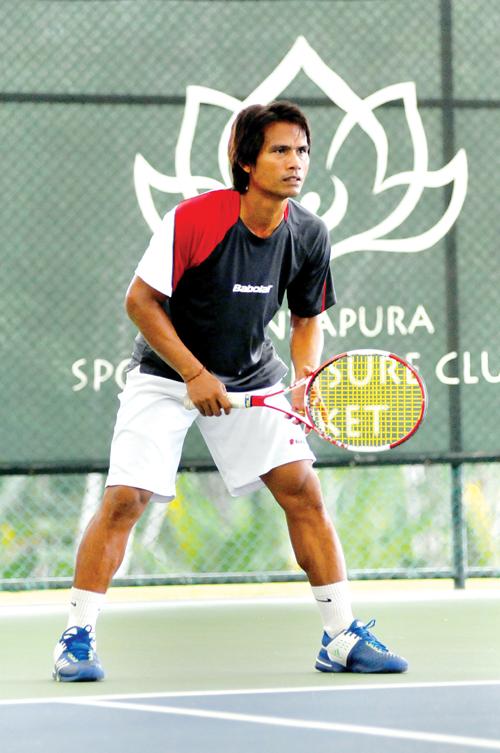Sporting Tips: Balance; lifting and pushing the limits

PHUKET: Thanyapura Sports & Leisure Club (TSLC) boasts some of the best sporting facilities in Asia, if not in the world and coaching staff to match.
The Phuket Gazette caught up with TSLC’s Tennis Head Coach Roger Cochrane, Fitness Manager Brian Finniss and Aquatics Head Coach Randy Simon to provide tips to “push the limits”.
Ensuring good balance – Roger Cochrane
Tennis, like a lot of things in life, is about balance.
There is the balance between how much power and how much control you try to hit. We have to balance how much we train and how much we rest our body, as well as the balance of offense and defense. The most important balance however is the balance of your body on court.
Keeping our body balanced means keeping our weight distributed evenly overtop of our feet. Generally if your feet are about as wide apart as your shoulders, and your knees a little bit bent (lowering your center of gravity) you will be fairly balanced.
When you are moving to the ball you want make every step more efficient so instead of taking big steps which are hard to adjust, little steps are better for getting you there and staying balanced.
When you are actually hitting the ball, it does not matter so much if your front foot is closer to the net or in line with your back foot, what matters is you are stable. This will allow you to be strong through the hitting zone and maintain a long contact area. This is true for forehands, backhands and especially the serve.
When you serve there is no reason you should not be balanced. You control when you serve, where you serve and how you serve. Make sure you are set before your serve and that you feel stable. Do not chase a bad ball toss and you will serve much better!
Dead lift vs hip hinge – Brian Finniss
How many of you have been to a gym and had a trainer tell you to do a dead lift?
A dead lift is a very common exercise that has many variations, but it can allow our body to be placed in a compromising position if we do not know how to bend properly from the hip and maintain correct posture throughout the range of motion.
Unfortunately at some point in our lifetime, most humans will have lower back pain which often can be traced back to improper bending or lifting techniques.
Before starting with a dead lift it is important to be taught a simple hip-hinge movement which teaches you how to bend properly from the hip and how to correctly use your core and the stabilizer muscles around your spine. Once the hip-hinge movement has been mastered then you can slowly start to add weight or resistance.
Start by holding the weight (a dumb bell, medicine ball, or kettlebell) close to your chest as you go through the movement. After you have mastered that you can begin to let the weight hang between your legs or slowly start to incorporate a barbell.
Remember the farther away from the mid-line of your body you hold a weight or resistance, the harder it becomes and the more stress that is placed on the body, in this case the lower lumbar spine.
Don’t get me wrong, I think dead lifts are one of the best exercises that anyone can do and highly recommend people start adding it to their training programs, but only after mastering the hip hinge movement first!
Pushing the limit – Randy Simon
Our bodies are great at adapting to stress. It forces our muscles to work in new ways and makes us stronger. However, as our bodies adapt, our muscles learn how to work through the stress more efficiently.
Sadly, our minds don’t always work in quite the same way. We resist change. For an athlete, this can be their worst enemy. Good athletes have habits that help them do well but great athletes look at where they are weak and find ways to develop new habits to improve.
Once we are good at something, we tend to stick with it, even after it stops working for us. In that way, for an athlete being good at something becomes the enemy of being great. Initial success will reinforce good habits, but can shift focus away from what we need to do to sustain or build on that success.
Look at the best athletes in any sport, and you’ll see they are good at many different aspects of their game, not just one portion of it. Good athletes can rely too much on what has worked for them in the past. Great athletes work on their weaknesses and develop their skills. In time they become great at everything.
So do you want to be good or do you want to be great?
Tips by Phuket’s TSLC’s Tennis Head Coach Roger Cochrane (tennis@thanyapura.com), Fitness Manager, Brian Finniss (Tslc@thanyapura.com) and Aquatics Head Coach, Randy Simon (aquatics@thanyapu(ra.com).
Keep checking our online Phuket Sports pages, join our Facebook fan page or follow us on Twitter @PhuketGazette for the latest local, national and international sporting news and action.
Latest Thailand News
Follow The Thaiger on Google News:


























